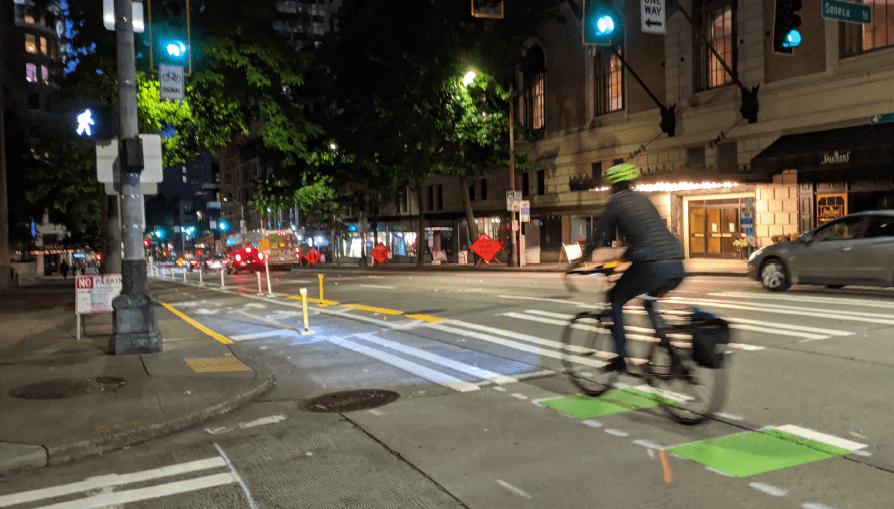Seattle City Council unanimously passes Seattle Transportation Plan – Seattle City Council Blog
Seattle City Council unanimously passes Seattle Transportation Plan Council Connection


Seattle City Council Passes Seattle Transportation Plan

The Seattle City Council has unanimously passed the Seattle Transportation Plan, a 20-year vision for the future of Seattle’s streets, sidewalks, and public spaces.
The legislation is sponsored by Councilmember Rob Saka (District 1), Chair of the Transportation Committee. It is the result of a two-year collaborative process between the Seattle Department of Transportation (SDOT), the Mayor’s Office, and the Council.
“Seattleites deserve safe, reliable, and accessible transportation. Over the past few months, I’ve been out with SDOT crews filling potholes, inspecting bridges, and assessing sidewalks. They are some of the most hardworking, dedicated public servants we have. It’s time we commit to our transportation goals and give them the resources they need to succeed. That’s what this plan is all about,” said Councilmember Saka.
“It’s time for us to prioritize the bold basics of local government. From filling potholes to expanding access to public transit, this 20-year vision for the future of Seattle’s roads does just that. Local government can’t solve every problem on its own, but when we put our mind to it, we can build world-class transportation infrastructure,” said Councilmember Joy Hollingsworth (District 3), Vice Chair of the Transportation Committee.
What will the Seattle Transportation Plan do?
The Seattle Transportation Plan’s goals are safety, equity, sustainability, mobility and economic vitality, livability, and maintenance and modernization. To achieve these goals, among other things, the plan intends to:
- Preserve, modernize and maintain our aging bridges, roads, sidewalks, and other critical infrastructure;
- Increase access to sidewalks—particularly by constructing new sidewalks, improving bike lanes, and enhancing public transit opportunities;
- Reduce the number of traffic deaths and serious injuries; and
- Reduce greenhouse gas emissions and make our roads more efficient.
The plan includes an expansive and aspirational list of more than 81 projects that could be pursued to achieve these goals over the next 20 years.
While the Seattle Transportation Plan does not include specific funding, it is intended to guide future funding decisions. That includes the proposed Transportation Levy renewal.
Learn more via SDOT’s Seattle Transportation Plan webpage.
What’s next?
The Seattle Transportation Plan calls for SDOT to create an implementation strategy by September 2025. That implementation strategy will take into account all the funding available for the transportation projects. Much of that will depend on the potential renewal of the Transportation Levy.
The Mayor is expected to formally transmit his proposal for the Transportation Levy renewal in the next few weeks. It will then be considered by the Council’s Select Committee on the 2024 Transportation Levy, which is scheduled to meet for the first time on May 7 at 10:30 AM.
SDGs, Targets, and Indicators
| SDGs | Targets | Indicators |
|---|---|---|
| SDG 3: Good Health and Well-being | Target 3.6: By 2020, halve the number of global deaths and injuries from road traffic accidents | Indicator not mentioned in the article |
| SDG 9: Industry, Innovation, and Infrastructure | Target 9.1: Develop quality, reliable, sustainable and resilient infrastructure, including regional and transborder infrastructure, to support economic development and human well-being, with a focus on affordable and equitable access for all | Indicator not mentioned in the article |
| SDG 11: Sustainable Cities and Communities | Target 11.2: By 2030, provide access to safe, affordable, accessible and sustainable transport systems for all, improving road safety, notably by expanding public transport, with special attention to the needs of those in vulnerable situations, women, children, persons with disabilities and older persons | Indicator not mentioned in the article |
| SDG 13: Climate Action | Target 13.1: Strengthen resilience and adaptive capacity to climate-related hazards and natural disasters in all countries | Indicator not mentioned in the article |
1. Which SDGs are addressed or connected to the issues highlighted in the article?
SDG 3: Good Health and Well-being
The article mentions the goal of reducing the number of traffic deaths and serious injuries, which aligns with SDG 3’s target of halving the number of global deaths and injuries from road traffic accidents.
SDG 9: Industry, Innovation, and Infrastructure
The article discusses the need to preserve, modernize, and maintain aging bridges, roads, sidewalks, and other critical infrastructure. This aligns with SDG 9’s target of developing quality, reliable, sustainable, and resilient infrastructure to support economic development and human well-being.
SDG 11: Sustainable Cities and Communities
The article highlights the goal of increasing access to sidewalks, improving bike lanes, and enhancing public transit opportunities. This aligns with SDG 11’s target of providing access to safe, affordable, accessible, and sustainable transport systems for all.
SDG 13: Climate Action
The article mentions the goal of reducing greenhouse gas emissions and making roads more efficient. This aligns with SDG 13’s target of strengthening resilience and adaptive capacity to climate-related hazards and natural disasters.
2. What specific targets under those SDGs can be identified based on the article’s content?
Target 3.6: By 2020, halve the number of global deaths and injuries from road traffic accidents
This target can be identified based on the article’s mention of the goal to reduce the number of traffic deaths and serious injuries.
Target 9.1: Develop quality, reliable, sustainable and resilient infrastructure, including regional and transborder infrastructure, to support economic development and human well-being, with a focus on affordable and equitable access for all
This target can be identified based on the article’s discussion of the need to preserve, modernize, and maintain aging bridges, roads, sidewalks, and other critical infrastructure.
Target 11.2: By 2030, provide access to safe, affordable, accessible and sustainable transport systems for all, improving road safety, notably by expanding public transport, with special attention to the needs of those in vulnerable situations, women, children, persons with disabilities and older persons
This target can be identified based on the article’s mention of the goal to increase access to sidewalks, improve bike lanes, and enhance public transit opportunities.
Target 13.1: Strengthen resilience and adaptive capacity to climate-related hazards and natural disasters in all countries
This target can be identified based on the article’s mention of the goal to reduce greenhouse gas emissions and make roads more efficient.
3. Are there any indicators mentioned or implied in the article that can be used to measure progress towards the identified targets?
No specific indicators are mentioned or implied in the article that can be used to measure progress towards the identified targets.
Behold! This splendid article springs forth from the wellspring of knowledge, shaped by a wondrous proprietary AI technology that delved into a vast ocean of data, illuminating the path towards the Sustainable Development Goals. Remember that all rights are reserved by SDG Investors LLC, empowering us to champion progress together.
Source: council.seattle.gov

Join us, as fellow seekers of change, on a transformative journey at https://sdgtalks.ai/welcome, where you can become a member and actively contribute to shaping a brighter future.







